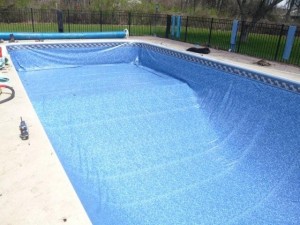
This information comes to us from the manufacturer (Kafko) that we have used for our liners for 20+ years.
Repair
Life happens. We have heard the stories about pole vaulting in the pool or using the pool as a practice green for pitching golf balls. The great thing about the liner is that if it does sustain a puncture or tear, it can usually be easily repaired with a simple patch kit. First, let’s talk about finding a leak in a pool, then we will discuss repair.
Find A Leak In My Swimming Pool
The proper method is to follow a step by step procedure of elimination. Before starting the leak procedure, make sure you do not have an obvious leak at the equipment pad or end of the backwash line. Look for unusual wet spots around the pool. Visually inspect the liner for a tear. Using a swim mask, visually check each of the seams on the liner for integrity. Pay special attention to where two seams cross or in the corners of geometric shapes. Make a game for the kids and have them examine the liner. If nothing is found, move to step 1.
Determine the amount of water loss to confirm a leak. It’s possible to lose more than 1” of water in a short period of time if the pool is getting a lot of use with many swimmers splashing about. Temperature inversion, wind, and humidity can also cause rapid evaporation of up to 3/8” a day. To establish the amount of water loss, place a bucket of water in the pool on your steps. Fill the bucket with pool water until it is level with the pool water level. Mark the water level on the inside and outside of the bucket and recheck levels 12, 24, and 36 hours later. Do this when the pool is receiving little or no use. If the pool level is falling below the level in the bucket by more than ½” in 12 hours, then you probably have a leak.
We need to eliminate plumbing leaks as a source of the water loss. Turn off the equipment, plug the inlets and skimmers, mark the water level, and keep swimmers out for 24 hours. Recheck in 24 hours. If the leak stops, you may need to have a professional repair company pressure test and repair the lines. If you are still losing water at the same rate as before, you should move to step 3.
Actually, you can begin this step at soon as the equipment has been turned off. We are going to test the various gaskets where the liner has been cut. Do this with a small squeeze bottle filled with water and food coloring. The Phenol red test solution bottle will also work. Starting at the step and with the water still, slowly squeeze the colored water within 1” of the side of the step flange. Begin on one side of the step flange and work around the bottom to the other side. If the gasket is leaking, you will notice the colored water being drawn towards the opening. If a leak is found and it is not a tear, simply retightening the screws may solve the problem. Actually, it is a good idea to retighten the screws anyway. If no leak is found at the step, move to the next cut out and repeat the procedure. All cutouts with flange and gaskets should be checked, including inlets, skimmers, and lights. The colored water should also be squeezed around the light to check for leaks in the back of the light niche. It may be necessary to remove the light to fully test the niche. Make sure you “dye” test the main drain if possible.
If no leak has been found and the pool is still leaking, you may need to let the water leak down until it stops. If it stops just below a cutout, re-inspect the fitting, gasket, and faceplate for damage. Retighten the screws. Visually inspect the liner within 1” of the water level all around the pool. Add a couple inches of water to the pool and see if the leak has been fixed. Do not let the pool leak down below the shallow end. If the pool continues to leak to near the shallow end, it may be necessary to call a professional to find the leak. Some companies use electronic leak detectors, geophones, and scuba gear to look for leaks. Once the leak has been found they are usually easy to repair.
How To Repair A Simple Hole In A Liner
Most pool stores offer simple adhesive patch kits for patching a vinyl liner. When properly applied, the patch should last as long as the entire liner. Here is the procedure for applying the patch.
It is always better to apply the patch behind the liner if possible. If the hole is above the water level, take a small amount of clear PVC pipe cleaner and clean the area to be patched. Be careful not to rub the pattern off the liner outside the patch area. If the hole is below water level, clean the area with an approved vinyl cleaner but be sure to remove cleaner residue.
Cut the patch material into a round or oval shape about 3 times larger than the hole. Most patch kits contain clear or solid color vinyl patch material. It is advisable to save some of the original liner material, either from the step or skimmer cutout, for just this occasion.
Apply the patch adhesive to the back of the patch. Spread evenly to the edges being careful not to spread so thick that it will flow outside the patch area when pressure is applied. Allow the adhesive to tack according to the instructions.
If the hole is above the water level, place the patch over the hole, smooth any wrinkles, and apply pressure evenly for 3-4 minutes.
If the hole is below water level, fold the patch in half so the adhesive side is lightly folded together. This is done to keep excess adhesive from possibly floating off the patch which could remove the pattern at the water line. Take the patch to the hole, unfold, and place on the hole. Smooth to spread out wrinkles and apply pressure for several minutes by standing on or placing a flat weighted object on the patch.
Dye test the patch as described in the find a leak section to make certain the repair is successful.
Larger tears in the corner can be repaired using the same method as above. In those situations it is better to take pressure off the liner in the corner by lowering the water level about 12” and then remove the liner bead from the track before patching. After patching, leave the liner out of the track for 6-8 hours before replacing the bead in the track and refilling.
Replacing a vinyl liner
If a liner cannot be patched effectively, or if it is old and a new liner is the better choice, we recommend that you call a pool professional who can measure your pool, have a liner created that exactly matches the specifications of your pool, and have it professionally installed. A vinyl liner is much less expensive than a gunite renovation – so homeowners considering a vinyl liner pool are going to be happy if there ever comes a time when the liner should be replaced.
Pietila Pools Services specializes in vinyl liner pool repair and replacement. Please call or send in a service request if you’d like more information about this service.











